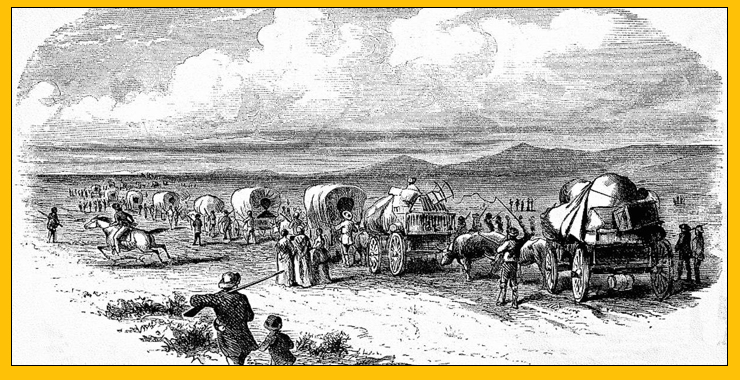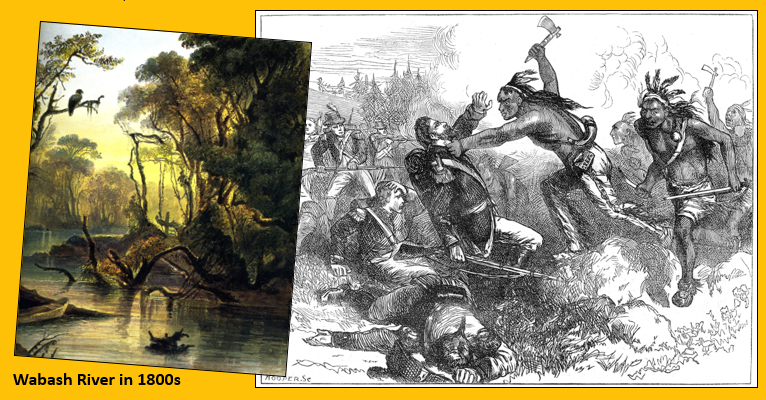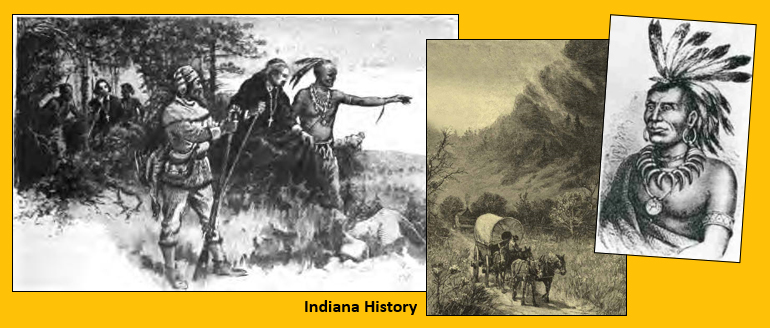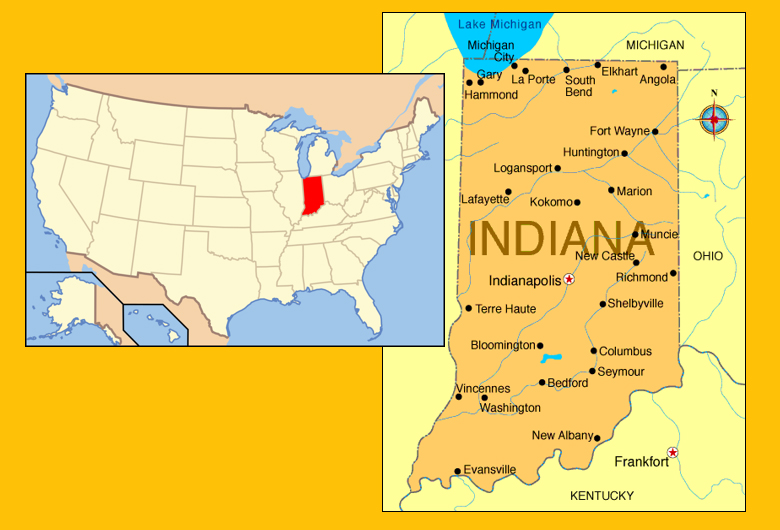“I grew up in a small town in northeastern Indiana. I had an all-American childhood. And I grew up as an optimist.”
- Mary Meeker, Hoosier native, noted
Wall Street venture capitalist

As every schoolchild in Caruthers Corners knows, the town was founded in 1829 by a wagon train of hardy pioneers led by Jacob Abernathy Caruthers, Ferdinand Aloysius Jinks, and Col. Beauregard Hollingsworth Madison. A broken wheel stranded them here on the banks of the Wabash River. The area had become the 19th State in 1816, but an estimated 2,500 Potawatomi remained in this land formerly designated as “Indian Territory” (hence the name “Indiana”).
Jacob Caruthers claimed the fertile land along the Wabash River for the refugees of his broken-down wagon train, squeezing out the Indians who occupied the flat banks of the meandering waterway. Also he claimed the name of the settlement for himself: Caruthers Corners. The Madison and Jinks descendants have quarreled over this inequity for years.
The Potawatomi did not welcome these interlopers. Chief Winamac and his Wabash Potawatomi attacked the settlers. The settlers responded with raids of their own. Back and forth. But few people were killed on either side.
That is, until the Battle of Gruesome Gorge. Now a state park, the Gorge is a natural canyon where a tribe of Potawatomi were encamped. Major Samuel Elmsford Beasley led an attack on them, slaughtering men, women, and children. Jacob Caruthers described it in his journal as “a goode turkee shoot.”

This massacre encouraged many Potawatomi to sell their land to the government and relocate to the new Indian Territory to the West – Kansas and Iowa, later Missouri and Oklahoma.
The Indian Relocation Act of 1830 had paved the way for the displacement of tens of thousands of Native Americans. On October 26, 1832, the Potawatomi gave up their land in Indiana, Illinois, and part of Michigan to the federal government with the Treaty of Tippecanoe.
In 1936 the Treaty of Yellow River offered the remaining Potawatomi $14,080 for two sections of Indiana land, but Chief Menominee and seventeen other chiefs refused to accept the terms of the sale, resulting in them being forcibly removed in what came to be known as the Potawatomi Trail of Death. Some 859 members of the Potawatomi nation were relocated from Indiana to reservation lands in what is now eastern Kansas. During the 660-mile journey more than 40 persons died. It marked the single largest Indian removal in Indiana history.

1679 – French explorer Rene-Robert Cavelier, Sieur de La Salle was the first European to cross into what would become Indiana Territory.
1702 – The first trading post on the Wabash River was established by Sieur Juchereau, Lieutenant General of Montreal to trade buffalo hides with the Indians.
1704 – Jean Baptiste Bissot, Sieur de Vincennes built a fur trading post and fort at the Miami village of Kekionga (the later site of Fort Wayne).
1732 – François-Marie Bissot, Sieur de Vincennes (son of Jean Baptiste Bissot) built a fur trading post and established Fort Vincennes.
1754-1763 – The French and Indian War.
1776-1787 – The Revolutionary War.
1800 – Indiana Territory was established from the Northwest Territory with William Henry Harrison as the first Governor and Vincennes as the capital.
1811 – A confederacy of Indians under Shawnee Chief Tecumseh were defeated by the Americans in the Battle of Tippecanoe.
1814 – A group of 800 people led by George Rapp moved into the Indiana Territory to found a utopian society. It ultimately failed.
1816 – Indiana became the 19th US State. Jonathan Jennings was appointed as the state's first Governor.
1825 – Indianapolis was made the state capitol.
1829 – The town of Caruthers Corners was founded when a wagon train was stranded due to a broken wheel.
1831 – Massacre of Gruesome Gorge. A group of Potawatomi encamped in Gruesome Gorge was ambushed by militia led by Major Samuel Elmsford Beasley.
1832 – The Potawatomi gave up their land in Indiana with the Treaty of Tippecanoe.
1838 – The Trail of Death, a forcible relocation by the US government of 859 members of the Potawatomi nation to lands west of the Mississippi.
1850 – Old Order Amish settled in northeastern Indiana.
1852 – The first Indiana State Fair was held on October 19-25 at Indianapolis.
1854 – The Burpyville Gazette was founded by Bob Tippey’s grandfather. (The newspaper remained a family business until recently, when Bob sold the paper to the Nightley Newspapers Group.)
1860 – A rapidly moving tornado passes through southeast Indianapolis.
1889 – The Great Tornado of 1889.
1896 – A meteorite landed in a field ten miles outside of Caruthers Corners. Reportedly, someone was killed by this stellar missive. A farm silo was destroyed.
1899 – The Great Conflagration, a fire that destroyed half of the town of Caruthers Corners. Started at the First Wabash National Bank and spread “like wildfire.” Supposedly started to cover up a bank robbery. The First Wabash National Bank never reopened its doors after the Great Fire.
1903 – The Indianapolis Star began publication in Indianapolis. (It is currently owned by the Gannet Company.)
1911 – The first Indy 500 car race took place in Indianapolis.
1913 – The Great Flood of 1913. Waters in the Wabash and White River rose 19.5 feet above flood stage in some areas. Over 7,000 families lost their homes.
1974 – Series of 148 tornadoes struck the Midwest (including Indiana). Many killed with severe property damage.
2012 – Series of powerful storms and tornadoes left 13 dead, destroyed town of Marysville.
2018 – The 2018 Northeastern Indiana Tornado devastated a third of the town of Caruthers Corners. Rebuilding is being funded largely by the Caruthers Corners Restoration Coalition.

The State of Indiana
Indiana was admitted as the 19th US State in 1816. The name means “Indian Land,” a reference to the large indigenous population who had lived in this region since 8000 BC or before.
Known as the “Hoosier State,” Indiana has a total population of 6,691,878 today, making it the 17th largest state. The capital and largest city is Indianapolis.
From affordability to opportunity, from automobile races to football games, Indiana is ranked as the 33rd Best State in the US (based on a US News survey). Its slogan is “Honest to Goodness Indiana.”
Famous people from the Indiana range from authors Booth Tarkington, Theodore Dreiser, and Kurt Vonnegut, Jr. to songwriters Cole Porter and Hoagy Carmichael, comedians Red Skelton and Herb Shriner, poets James Whitcomb Riley and Joaquin Miller, TV host David Letterman, actors James Dean and Carol Lombard, journalist Ernie Pyle, mystery writer Rex Stout, airplane inventor Wilbur Wright, astronaut Virgil Grissom, labor leader Jimmy Hoffa, fashion designer Bill Blass, singer John Mellencamp, and King of Pop Michael Jackson.
Indiana has its own official river (Wabash), its own state bird (Cardinal), its own tree (Tulip Tree), its own flower (Peony), its own favorite pie (Sugar Cream Pie), its own poem (“Indiana” by Arthur F. Mapes), its own song (“On the Banks of the Wabash Far Away” by Paul Dresser), and its own insect (firefly). Even its own official firearm (Grouseland Rifle).
The State of Indiana covers 35,867 square miles. It borders Michigan to the north, Ohio to the east, Kentucky to the south and southeast, and Illinois to the west. Lake Michigan caps it off to the northwest.
Indiana’s motto is “Crossroads to America.”
|







